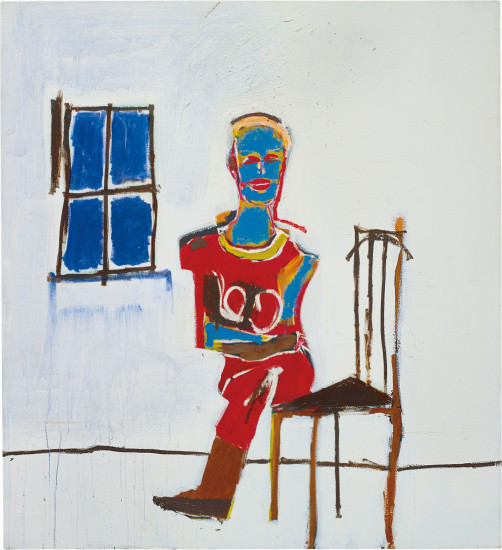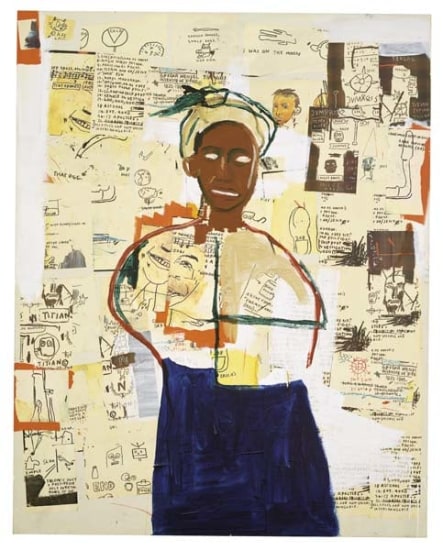Jean-Michel-Basquiat Bird as Buddha 1984 acrylic, oilstick on canvas 63 x 60 in. (160 x 152.4 cm) Signed, titled and dated '"BIRD AS BUDDHA' Jean-Michel-Basquiat 1984" on the reverse.
Provenance Mary Boone Gallery, New York Private Collection Christie's New York, Contemporary Art Sale, May 12, 2004, lot 391 Private Collection Exhibited New York, Mary Boone Gallery, Jean-Michel-Basquiat, 1984 Literature Jean-Michel-Basquiat,exh. cat., Mary Boone Gallery, New York, 1984, no. 6 (illustrated) R. Marshall J. Prat, Jean-Michel-Basquiat, Paris: Galerie Enrico Navarra, 1996, vol. II, p. 132, no. 4 (illustrated) R. Marshall J. Prat, Jean-Michel-Basquiat, Paris: Galerie Enrico Navarra, 2000, p. 217, no. 4 (illustrated) Catalogue Essay "I don't think about art when I'm working. I try to think about life." Jean-Michel-Basquiat At the height of both his fame and prolificacy in 1984, Jean-Michel-Basquiat churned out works on canvas, wood, and variety of other mediums with astonishing speed. By this time, he had already consolidated a substantial amount of the symbology that he is now known for: his x-rayed anatomy, his use of crowns and religious motifs, his spare and cryptic lettering, and, of course, his veneration of storied childhood heroes. Stylistically, however, Basquiat rarely repeated himself, as it was his neo-Expressionist tendency to improvise while working. This system of measured spontaneity has bequeathed to us a fantastic variety of related imagery, where two visually dissimilar works can possess a wealth of common icons. One such favored subject, the legendary jazz musician Charlie Parker, surfaced again and again, eponymously addressed by Basquiat as “Bird”—Parker’s equally famous nickname. Bird as Buddha, 1984 represents one of Basquiat’s most eloquently personal works: a meditation on the marriage of spirit and heroism. Similar to Basquiat’s own artistic precocity, Charlie Parker led one of the most distinguished careers in jazz despite passing away at only 34. Basquiat would unfortunately share this early fate, but not without finding a kindred spirit in the figure of Parker, who influenced Basquiat’s art in multiple aspects. In addition to making frequent appearances on his canvasses themselves, Parker’s music often filled the room of Basquiat’s studios (he was rumored to listened to an endless stream of Parker recordings while he worked). But their marriage of minds does not stop there—both Parker and Basquiat are responsible for intellectualizing their art forms to a major degree: Parker worked against the lingering racism of minstrelsy and jazz as solely entertainment, while Basquiat worked against the prevailingly white art establishment as a mixed race and multicultural young artist. Upon the canvas, Parker’s form is certainly unrecognizable without Basquiat’s titular accompaniment, scrawled on the back of his canvas. Working in a rash and breathtakingly exciting manner of application, Basquiat makes the present lot stand out within the scope of his oeuvre, partially due to its singular and central figure, but also due to the chromatic luxuriousness of his palette. The latter aspect gains its fabulous variety from Basquiat’s dichotomy of two main colors in the background of his figure: at the upper corners of his picture, blocks of gray lend the painting a rare chromatic symmetry for Basquiat’s work. His brushwork, quick and lightly textured (signaling relatively diluted acrylic), is present and plentiful, the many cascading gestures of white and black like so many hairs on the back of an aging scalp. Alternatively, Basquiat offsets his duller pigment with pockets of bright blue, haloed around the crest of the subject’s head yet also appearing in the space between his legs and in the lower right quadrant. Basquiat applies the blue coloring with far more unity of texture and color, implying a slower, more meticulous process. Taken together, both the blue and gray give us an impression of an interior space that the subject is currently occupying—the bright blue light of day shines behind him. Yet Basquiat’s infinitely complex background details are obviously second to his central figure as the
Jean-Michel-Basquiat Bird as Buddha 1984 acrylic, oilstick on canvas 63 x 60 in. (160 x 152.4 cm) Signed, titled and dated '"BIRD AS BUDDHA' Jean-Michel-Basquiat 1984" on the reverse.
Provenance Mary Boone Gallery, New York Private Collection Christie's New York, Contemporary Art Sale, May 12, 2004, lot 391 Private Collection Exhibited New York, Mary Boone Gallery, Jean-Michel-Basquiat, 1984 Literature Jean-Michel-Basquiat,exh. cat., Mary Boone Gallery, New York, 1984, no. 6 (illustrated) R. Marshall J. Prat, Jean-Michel-Basquiat, Paris: Galerie Enrico Navarra, 1996, vol. II, p. 132, no. 4 (illustrated) R. Marshall J. Prat, Jean-Michel-Basquiat, Paris: Galerie Enrico Navarra, 2000, p. 217, no. 4 (illustrated) Catalogue Essay "I don't think about art when I'm working. I try to think about life." Jean-Michel-Basquiat At the height of both his fame and prolificacy in 1984, Jean-Michel-Basquiat churned out works on canvas, wood, and variety of other mediums with astonishing speed. By this time, he had already consolidated a substantial amount of the symbology that he is now known for: his x-rayed anatomy, his use of crowns and religious motifs, his spare and cryptic lettering, and, of course, his veneration of storied childhood heroes. Stylistically, however, Basquiat rarely repeated himself, as it was his neo-Expressionist tendency to improvise while working. This system of measured spontaneity has bequeathed to us a fantastic variety of related imagery, where two visually dissimilar works can possess a wealth of common icons. One such favored subject, the legendary jazz musician Charlie Parker, surfaced again and again, eponymously addressed by Basquiat as “Bird”—Parker’s equally famous nickname. Bird as Buddha, 1984 represents one of Basquiat’s most eloquently personal works: a meditation on the marriage of spirit and heroism. Similar to Basquiat’s own artistic precocity, Charlie Parker led one of the most distinguished careers in jazz despite passing away at only 34. Basquiat would unfortunately share this early fate, but not without finding a kindred spirit in the figure of Parker, who influenced Basquiat’s art in multiple aspects. In addition to making frequent appearances on his canvasses themselves, Parker’s music often filled the room of Basquiat’s studios (he was rumored to listened to an endless stream of Parker recordings while he worked). But their marriage of minds does not stop there—both Parker and Basquiat are responsible for intellectualizing their art forms to a major degree: Parker worked against the lingering racism of minstrelsy and jazz as solely entertainment, while Basquiat worked against the prevailingly white art establishment as a mixed race and multicultural young artist. Upon the canvas, Parker’s form is certainly unrecognizable without Basquiat’s titular accompaniment, scrawled on the back of his canvas. Working in a rash and breathtakingly exciting manner of application, Basquiat makes the present lot stand out within the scope of his oeuvre, partially due to its singular and central figure, but also due to the chromatic luxuriousness of his palette. The latter aspect gains its fabulous variety from Basquiat’s dichotomy of two main colors in the background of his figure: at the upper corners of his picture, blocks of gray lend the painting a rare chromatic symmetry for Basquiat’s work. His brushwork, quick and lightly textured (signaling relatively diluted acrylic), is present and plentiful, the many cascading gestures of white and black like so many hairs on the back of an aging scalp. Alternatively, Basquiat offsets his duller pigment with pockets of bright blue, haloed around the crest of the subject’s head yet also appearing in the space between his legs and in the lower right quadrant. Basquiat applies the blue coloring with far more unity of texture and color, implying a slower, more meticulous process. Taken together, both the blue and gray give us an impression of an interior space that the subject is currently occupying—the bright blue light of day shines behind him. Yet Basquiat’s infinitely complex background details are obviously second to his central figure as the

.jpg)









Try LotSearch and its premium features for 7 days - without any costs!
Be notified automatically about new items in upcoming auctions.
Create an alert